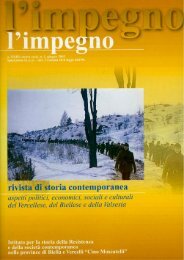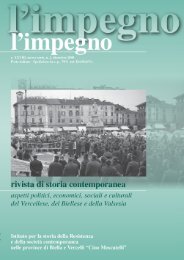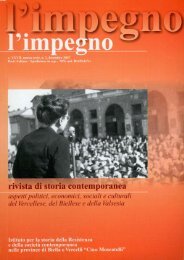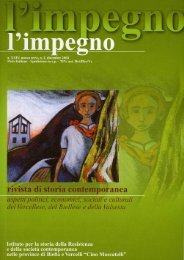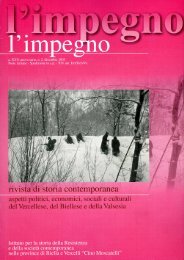Le vicende del confine orientale ed il mondo della scuola
Le vicende del confine orientale ed il mondo della scuola
Le vicende del confine orientale ed il mondo della scuola
Create successful ePaper yourself
Turn your PDF publications into a flip-book with our unique Google optimized e-Paper software.
<strong>Le</strong> <strong>vicende</strong> de L <strong>confine</strong> orient a <strong>Le</strong> <strong>ed</strong> i L <strong>mondo</strong> de LLa s cuo La • 21<br />
sia etrusca 21 ]. Alternativamente propone derivazione da IE. *gˆhewejā, *gˆhowejā,<br />
da collegare con gr. omer. ceihv, ceeiva ‘buco/a, grotta, tana, nascondiglio’, che,<br />
a sua volta, come *ce¸es-≤a–, dovrebbe riallacciarsi a gr. cavo" n. ‘leerer Raum;<br />
Kluft’ da *ca¸o" 22 . Speculazioni? La fantasia dei glottologi, che pure si professano<br />
scienziati rigorosi, non ha nulla da invidiare a quella degli artisti creativi.<br />
V<strong>ed</strong>i anche Ernout-Me<strong>il</strong>let, Dictionnaire étymologique de la langue latine,<br />
Paris, 1967 4 , p. 250: «<strong>Le</strong> rapprochement avec hom. ceihv ‘trou du serpent’,<br />
médiocre pour le sens, n’explique pas f initiale du latin. Fouea est peut-être à<br />
rapprocher de fauissa; étrusque? V. Ernout, Ph<strong>il</strong>ologica, I, p. 35» 23 . Non stupisce,<br />
dunque, che M. De Vaan, Etymological Dictionary of Latin and the Other<br />
Italic Languages, <strong>Le</strong>iden-Boston, 2008 [= De Vaan], sentenzi (con Schrijver):<br />
«The connection with gr. ceiav, H. ceihv ‘serpent’s den’ must be dismiss<strong>ed</strong>. It is<br />
uncertain that fovea and favīsae belong together, as their etymology is unknown».<br />
Fino alla metà <strong>del</strong> XX secolo, l’opinione dei glottologi germanici era (quasi)<br />
invariab<strong>il</strong>mente contestata dai glottologi francofoni e viceversa. Ernout-Me<strong>il</strong>let<br />
afferma che lat. f- non può derivare da IE *g/gˆh-. Walde-Hofmann e seguaci<br />
sanno bene che IE *g/gˆh- non dà lat. f- ma h- (sabell. h, gr. c, ai. gh/h, celt. g,<br />
germ. g, balt. g/ž, slav. g/z, armen. g/j[dz], itt. k/g, toc. k) 24 . In effetti, l’equa-<br />
tino]). Notizie sulla legge di Thurneysen e Havet in N.E. Collinge, The laws of Indo-European, Amsterdam-Ph<strong>il</strong>a<strong>del</strong>fia,<br />
PA 1985, pp. 193-195 («The upshot is that the law is usually accept<strong>ed</strong>, at least<br />
as applying to the string /-ŏwV-/ with following stress»). Studio specifico: Brent Vine, On in Latin and Italic, in «Historische Sprachforschung», 119, 2006, pp. 211-249.<br />
21. Pokorny IEW, p. 451 segue Walde-Hofmann mettendo lat. fovea sotto «IE *ghewjā (*gˆhewejā)<br />
‘Grube, Höhle’? Nur griech. und lat.» e precisando che «favissae ‘unterirdische Kammern’, mit<br />
etrusk. Suffix, kann hybride B<strong>il</strong>dung sein».<br />
22. Per gr. cavo" (> lat. chaos > it. caos), cfr. Frisk, Griechisches Etymologisches Wörterbuch [= Frisk<br />
GEW] II, Hei<strong>del</strong>berg, 1973, pp. 1072-1073 e Pokorny IEW, p. 449 s. gˆheu- ‘sbadigliare, aprirsi,<br />
spalancarsi’, con imponente bibliografia.<br />
23. Stuart E. Mann, An Indo-European Dictionary, Hamburg, 1984/87, col. 417 propone<br />
IE *gˆhewos ‘hollow’ in arm. dzor, o-st. ‘valley’, gr. kheiá, kheiē´‚ ‘hole, den’, lat. fovea, id., ecc.<br />
24. Cfr. G. Meiser, Historische Laut- und Formenlehre der lateinischen Sprache, Darmstadt, 1998<br />
[= Meiser HLuFLdLS], p. 103. Vd. <strong>Le</strong>umann LLuFL, pp. 164-5: IE gˆ h in italico c (ach-Laut) ><br />
o.-u. h in tutte le posizioni, ma lat. h in posizione iniziale davanti a vocale (tranne u) e internamente<br />
fra vocali (altrimenti > g). Esempi di h-: lat. hiems, gr. ciwvn, avest. zyā; lat. holus (antico<br />
pl. helusa), asl. zelije; lat. ha<strong>ed</strong>us, got. gaiti-, t<strong>ed</strong>. Geiß; lat. homo, got. guma; Esempi di -h- intervocalico:<br />
lat. veho, ai. vah, avest. vaz-, t<strong>ed</strong>. be-wege, gr. iter. ojcevomai; IE gh > lat. hostis, got. gasti-,<br />
t<strong>ed</strong>. Gast; lat. hortus, gr. covrto", got. gards. IE *gˆhu- diventa invece lat. fu-: fundo, got. giuta (t<strong>ed</strong>.<br />
gieße), gr. omer. cuv-to, ai. hu, av. zu. <strong>Le</strong>umann non prende in considerazione fovea. Al contrario<br />
di Sommer Handbuch, p. 196, che presenta fovea tra gli esempi di scambio tra f- e h-, cf. f- : h-<br />
(normale) in fo<strong>ed</strong>us, fēdus = ha<strong>ed</strong>us, fircus = hircus, fordeum = hordeum, fariolus = hariolus, folus<br />
= holus, fostis = hostis; solo f-: in fel- vs. gr. covlo", t<strong>ed</strong>. Galle, fovea vs. gr. ceiav; f- (normale): h- in<br />
haba = faba, hordus = fordus, hebris = febris, horctus accanto a forctus ‘buono’ (= fortis < IE *dergˆh-).<br />
Nell’aggiornamento <strong>del</strong> manuale di Sommer, R. Pfister non può fare a meno di r<strong>il</strong>evare, però, che<br />
«die Herkunf des f in fel, fovea, faux aus unlabialisiertem gˆ h oder gh (velar) ist ganz unsicher (W-H 3 )»<br />
(F. Sommer, Handbuch der lateinischen Laut- und Formenlehre, Vierte, neubearbeitete Auflage, Band<br />
I: Einleitung und Lautlehre von R. Pfister, Hei<strong>del</strong>berg, 1977, p. 149). Sulla osc<strong>il</strong>lazione h-/f-, cfr. an-<br />
inter venti



